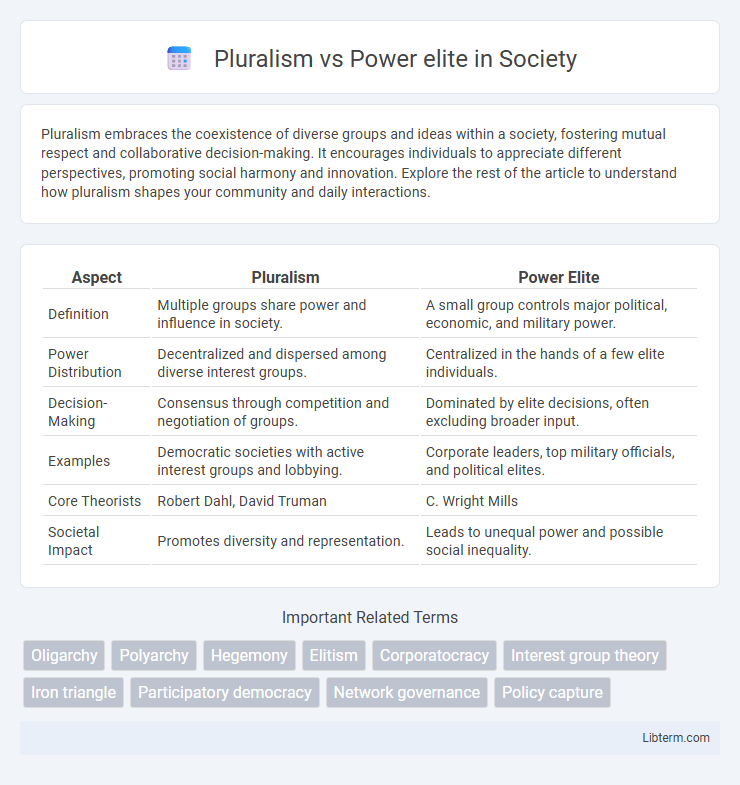Pluralism embraces the coexistence of diverse groups and ideas within a society, fostering mutual respect and collaborative decision-making. It encourages individuals to appreciate different perspectives, promoting social harmony and innovation. Explore the rest of the article to understand how pluralism shapes your community and daily interactions.
Table of Comparison
| Aspect | Pluralism | Power Elite |
|---|---|---|
| Definition | Multiple groups share power and influence in society. | A small group controls major political, economic, and military power. |
| Power Distribution | Decentralized and dispersed among diverse interest groups. | Centralized in the hands of a few elite individuals. |
| Decision-Making | Consensus through competition and negotiation of groups. | Dominated by elite decisions, often excluding broader input. |
| Examples | Democratic societies with active interest groups and lobbying. | Corporate leaders, top military officials, and political elites. |
| Core Theorists | Robert Dahl, David Truman | C. Wright Mills |
| Societal Impact | Promotes diversity and representation. | Leads to unequal power and possible social inequality. |
Introduction to Pluralism and Power Elite Theories
Pluralism theory emphasizes the distribution of power across various interest groups, suggesting that no single entity dominates political decision-making in a democracy. In contrast, the Power Elite theory argues that a small group of influential individuals hold disproportionate control over political, economic, and military institutions. Understanding these foundational theories highlights the ongoing debate about who truly governs and how power is exercised in society.
Historical Background of Both Concepts
Pluralism, emerging in the mid-20th century primarily through scholars like Robert Dahl, conceptualizes power as distributed among multiple interest groups competing within a democratic framework, reflecting the diverse interests of society. The Power Elite theory, articulated by C. Wright Mills in his 1956 seminal work "The Power Elite," argues that a small, interconnected group of political, military, and economic leaders dominate decision-making processes, undermining democratic pluralism. Both theories arose in the context of post-World War II America, responding to growing concerns about centralized authority and social inequality in modern industrial societies.
Key Definitions: Pluralism vs. Power Elite
Pluralism describes a political framework where multiple interest groups coexist and compete, ensuring that power is distributed broadly across society, fostering democratic participation. In contrast, the Power Elite theory posits that a small, interconnected group of individuals holds dominant control over major institutions like government, corporations, and the military, concentrating decision-making power in their hands. These key definitions highlight the fundamental difference between decentralized influence in pluralism and centralized authority in the power elite concept.
Core Principles of Pluralism
Pluralism emphasizes the distribution of power among multiple interest groups, ensuring no single entity dominates political decisions. Core principles include the recognition of diverse and competing groups, the accessibility of political participation for all citizens, and the importance of negotiation and compromise in policy-making. This framework contrasts sharply with the power elite theory, which argues that a small, unified group controls major societal decisions.
Central Ideas of Power Elite Theory
Power Elite Theory centers on the concept that a small group of individuals holding key positions in corporations, government, and the military dominate decision-making processes and control major institutions in society. This elite group's interconnected interests shape national policies, limiting widespread public participation and concentrating power in their hands. The theory highlights the disparity between this dominant group's influence and the broader public's limited role in political power structures.
Major Proponents and Influential Works
Robert Dahl and David B. Truman are major proponents of pluralism, emphasizing the distribution of power across diverse interest groups, with Dahl's "Who Governs?" analyzing power dynamics in New Haven. C. Wright Mills is a key figure of the power elite theory, outlined in his seminal work "The Power Elite," which argues that a small group of military, corporate, and political leaders dominate American society. These works remain foundational in understanding contrasting views on political power concentration and societal influence.
Case Studies: Pluralism in Modern Societies
Case studies of pluralism in modern societies demonstrate diverse interest groups influencing policy decisions through negotiated compromise and decentralized power structures. Examples include the United States, where multiple advocacy groups, labor unions, and business coalitions participate actively in the democratic process, balancing competing interests. This contrasts with power elite models by illustrating a more dispersed distribution of authority among various social actors and institutions.
Evidence of Power Elite in Contemporary Politics
Contemporary politics reveals evidence of the power elite through the concentration of decision-making authority in a small group of individuals within corporate, military, and political sectors. Studies show that elite networks often overlap in key government positions and major corporations, reinforcing their dominance over policy agendas and public resources. This centralization contrasts with pluralist theory by highlighting limited access to power rather than widespread participation across diverse interest groups.
Criticisms and Limitations of Each Theory
Pluralism faces criticism for underestimating the influence of powerful interest groups and overestimating equal participation among diverse social groups, often failing to address systemic inequalities embedded in political decision-making. The Power Elite theory is limited by its sometimes overly simplistic portrayal of societal control, neglecting the complexities of institutional checks and balances and the potential for dissent within elite circles. Both theories struggle to fully capture the dynamic interactions between various social actors, highlighting the need for more integrative frameworks to understand power distribution comprehensively.
Conclusion: Implications for Democracy and Governance
Pluralism promotes democratic governance by encouraging diverse interest groups to compete for influence, ensuring that no single entity monopolizes political power. In contrast, the power elite theory highlights the concentration of authority among a small, interconnected group, potentially undermining democratic principles by limiting broad-based participation. Understanding this tension informs the need for institutional checks and civic engagement to balance power and preserve responsive governance.
Pluralism Infographic

 libterm.com
libterm.com